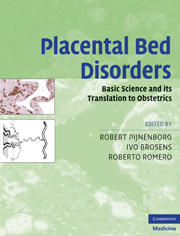Crossref Citations
This Book has been
cited by the following publications. This list is generated based on data provided by Crossref.
Parham, Peter
and
Guethlein, Lisbeth A.
2010.
Pregnancy immunogenetics: NK cell education in the womb?.
Journal of Clinical Investigation,
Vol. 120,
Issue. 11,
p.
3801.
Kingdom, John
Walker, Melissa
Drewlo, Sascha
and
Keating, Sarah
2012.
Fetal Therapy.
p.
341.
Henrich, Wolfgang
and
Hafner, Erich
2013.
Ultraschalldiagnostik in Geburtshilfe und Gynäkologie.
p.
379.
Chaemsaithong, Piya
Chaiworapongsa, Tinnakorn
Romero, Roberto
Korzeniewski, Steven J.
Stampalija, Tamara
Than, Nandor Gabor
Dong, Zhong
Miranda, Jezid
Yeo, Lami
and
Hassan, Sonia S.
2014.
Maternal plasma soluble TRAIL is decreased in preeclampsia.
The Journal of Maternal-Fetal & Neonatal Medicine,
Vol. 27,
Issue. 3,
p.
217.
Chaiworapongsa, Tinnakorn
Chaemsaithong, Piya
Yeo, Lami
and
Romero, Roberto
2014.
Pre-eclampsia part 1: current understanding of its pathophysiology.
Nature Reviews Nephrology,
Vol. 10,
Issue. 8,
p.
466.
Furukawa, Satoshi
Kuroda, Yusuke
and
Sugiyama, Akihiko
2014.
A Comparison of the Histological Structure of the Placenta in Experimental Animals.
Journal of Toxicologic Pathology,
Vol. 27,
Issue. 1,
p.
11.
Sanders, Clara E.
and
Hess, Philip E.
2015.
Updates in Preeclampsia.
Current Anesthesiology Reports,
Vol. 5,
Issue. 1,
p.
74.
Lee, Ji Soo
Romero, Roberto
Han, Yu Mi
Kim, Hee Chan
Kim, Chong Jai
Hong, Joon-Seok
and
Huh, Dongeun
2016.
Placenta-on-a-chip: a novel platform to study the biology of the human placenta.
The Journal of Maternal-Fetal & Neonatal Medicine,
Vol. 29,
Issue. 7,
p.
1046.
Depoix, C L
Haegeman, F
Debiève, F
and
Hubinont, C
2018.
Is 8% O2 more normoxic than 21% O2 for long-term in vitro cultures of human primary term cytotrophoblasts?.
MHR: Basic science of reproductive medicine,
Vol. 24,
Issue. 4,
p.
211.
Henrich, W.
and
Hafner, E.
2018.
Ultraschalldiagnostik in Geburtshilfe und Gynäkologie.
p.
427.
Popovych, A. I.
2018.
Immunohistochemical Study of Platcentary Lactogen and Placentary Alkaline Phosphatase in the Trophoblast of Chorionic Villi in Placental Calcnosis in Pregnant Women with Iron-deficiency Anemia.
Ukraïnsʹkij žurnal medicini, bìologìï ta sportu,
Vol. 3,
Issue. 3,
p.
39.
Xu, Xiuxiu
Zhou, Yonggang
and
Wei, Haiming
2020.
Roles of HLA-G in the Maternal-Fetal Immune Microenvironment.
Frontiers in Immunology,
Vol. 11,
Issue. ,
Jha, Priyanka
Pōder, Liina
Bourgioti, Charis
Bharwani, Nishat
Lewis, Sara
Kamath, Amita
Nougaret, Stephanie
Soyer, Philippe
Weston, Michael
Castillo, Rosa P.
Kido, Aki
Forstner, Rosemarie
and
Masselli, Gabriele
2020.
Society of Abdominal Radiology (SAR) and European Society of Urogenital Radiology (ESUR) joint consensus statement for MR imaging of placenta accreta spectrum disorders.
European Radiology,
Vol. 30,
Issue. 5,
p.
2604.
Tiulienieva, OlenaA
Tsagkaris, Christos
Davydenko, IgorS
Hoian, AnastasiiaV
Yasnikovska, SvitlanaM
and
Hovornyan, SerhiyL
2021.
Immunohistochemical evaluation of extravillous cytotrophoblasts in the uteroplacental bed in iron-deficiency anemia of pregnancy.
Journal of Medical Sciences,
Vol. 41,
Issue. 6,
p.
280.
Tiulienieva, O. A.
Davydenko, I. S.
Hoian, A. V.
and
Tiulienieva, V. O.
2021.
Histochemical Evaluation of the Processes of Protein Oxidative Modification in the Extravillous Cytotrophoblast of the Utero-Placental Bed during Iron-Deficiency Anemia in Pregnancy.
Ukraïnsʹkij žurnal medicini, bìologìï ta sportu,
Vol. 6,
Issue. 1,
p.
46.
Lu, Tao
Wang, Yishuang
Guo, Aiwen
Deng, Yan
Wu, Chengqian
Li, Xiangqi
and
Liu, Siyun
2022.
Correlation of placental thickness and PAS disorders: findings from MRI.
Abdominal Radiology,
Vol. 47,
Issue. 3,
p.
1150.
Sakowicz, Agata
Bralewska, Michalina
Kamola, Piotr
and
Pietrucha, Tadeusz
2022.
Reliability of Rodent and Rabbit Models in Preeclampsia Research.
International Journal of Molecular Sciences,
Vol. 23,
Issue. 22,
p.
14344.
Abel, Tashlen
Moodley, Jagidesa
Khaliq, Olive P.
and
Naicker, Thajasvarie
2022.
Vascular Endothelial Growth Factor Receptor 2: Molecular Mechanism and Therapeutic Potential in Preeclampsia Comorbidity with Human Immunodeficiency Virus and Severe Acute Respiratory Syndrome Coronavirus 2 Infections.
International Journal of Molecular Sciences,
Vol. 23,
Issue. 22,
p.
13752.
Yagel, S.
Cohen, S. M.
Goldman‐Wohl, D.
and
Beharier, O.
2023.
Redefining pre‐eclampsia as Type I or II: implementing an integrated model of the maternal‐cardiovascular–placental–fetal array.
Ultrasound in Obstetrics & Gynecology,
Vol. 61,
Issue. 3,
p.
293.





